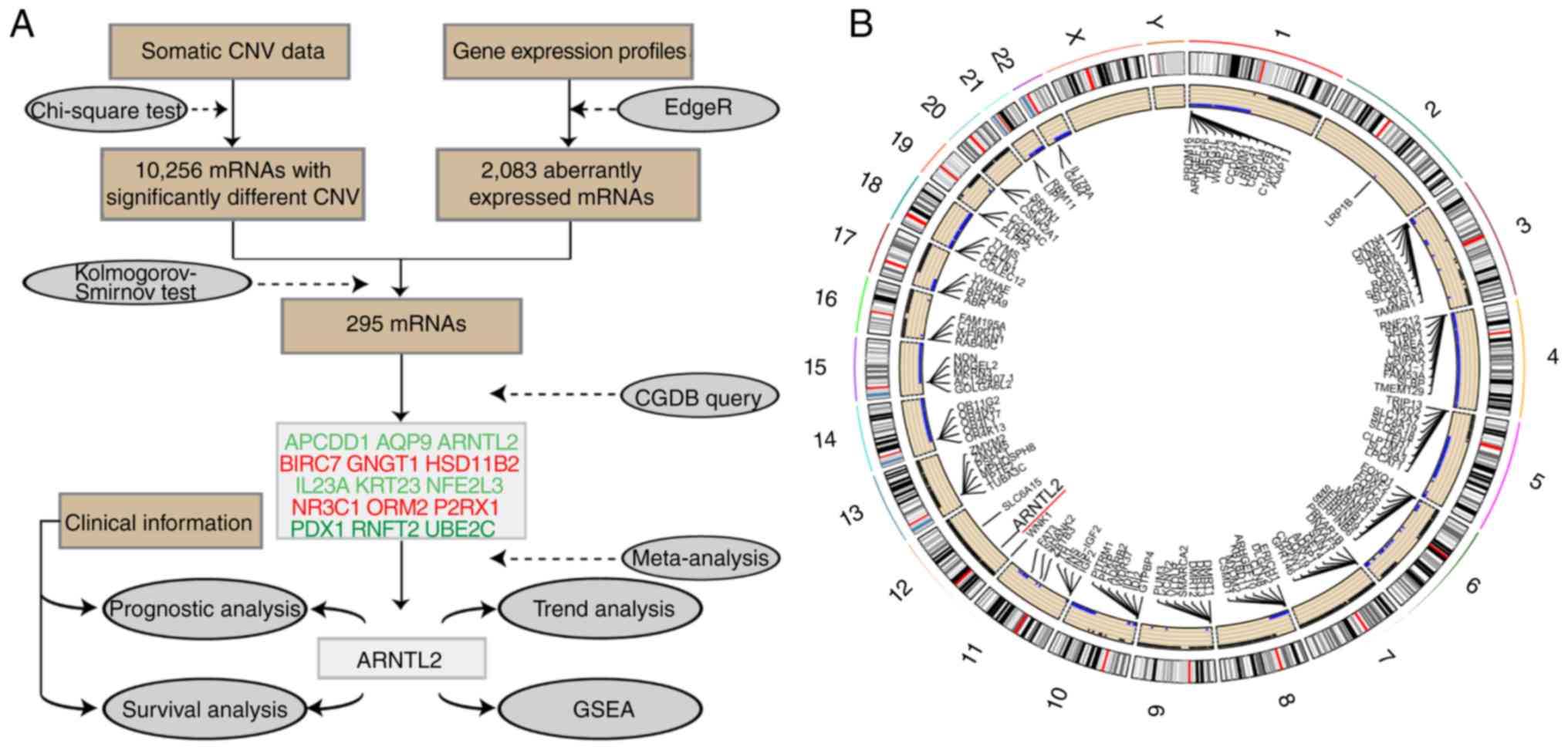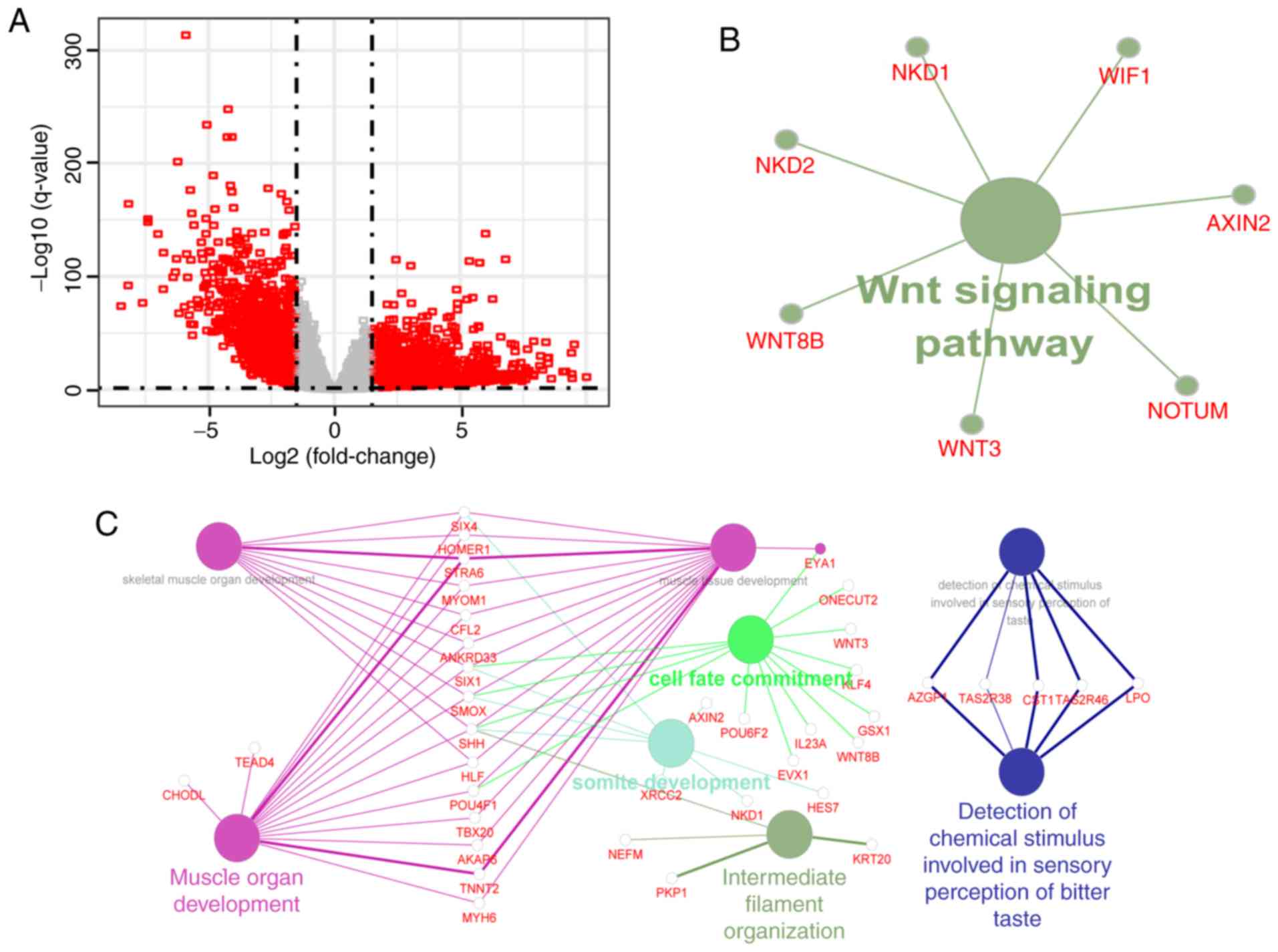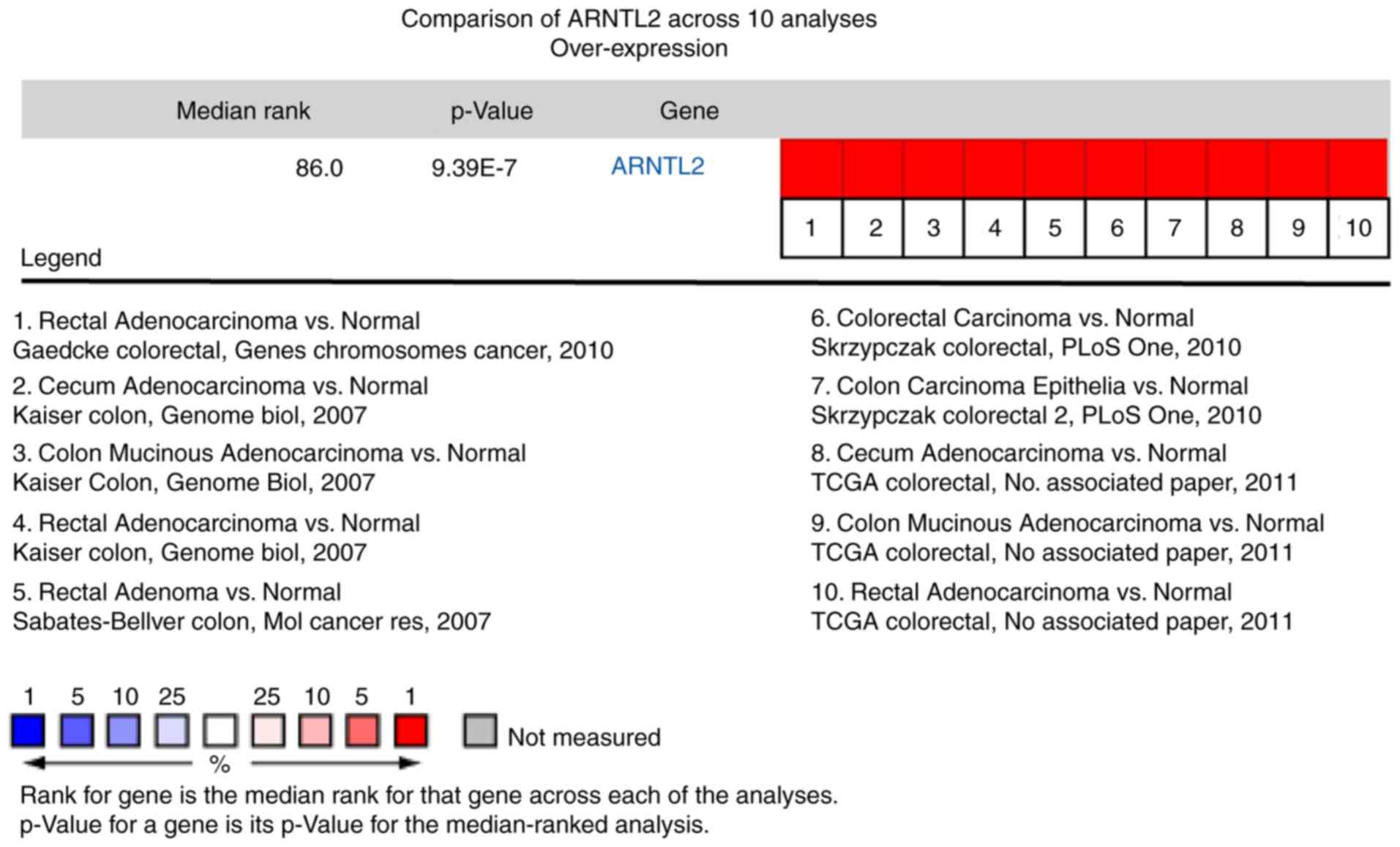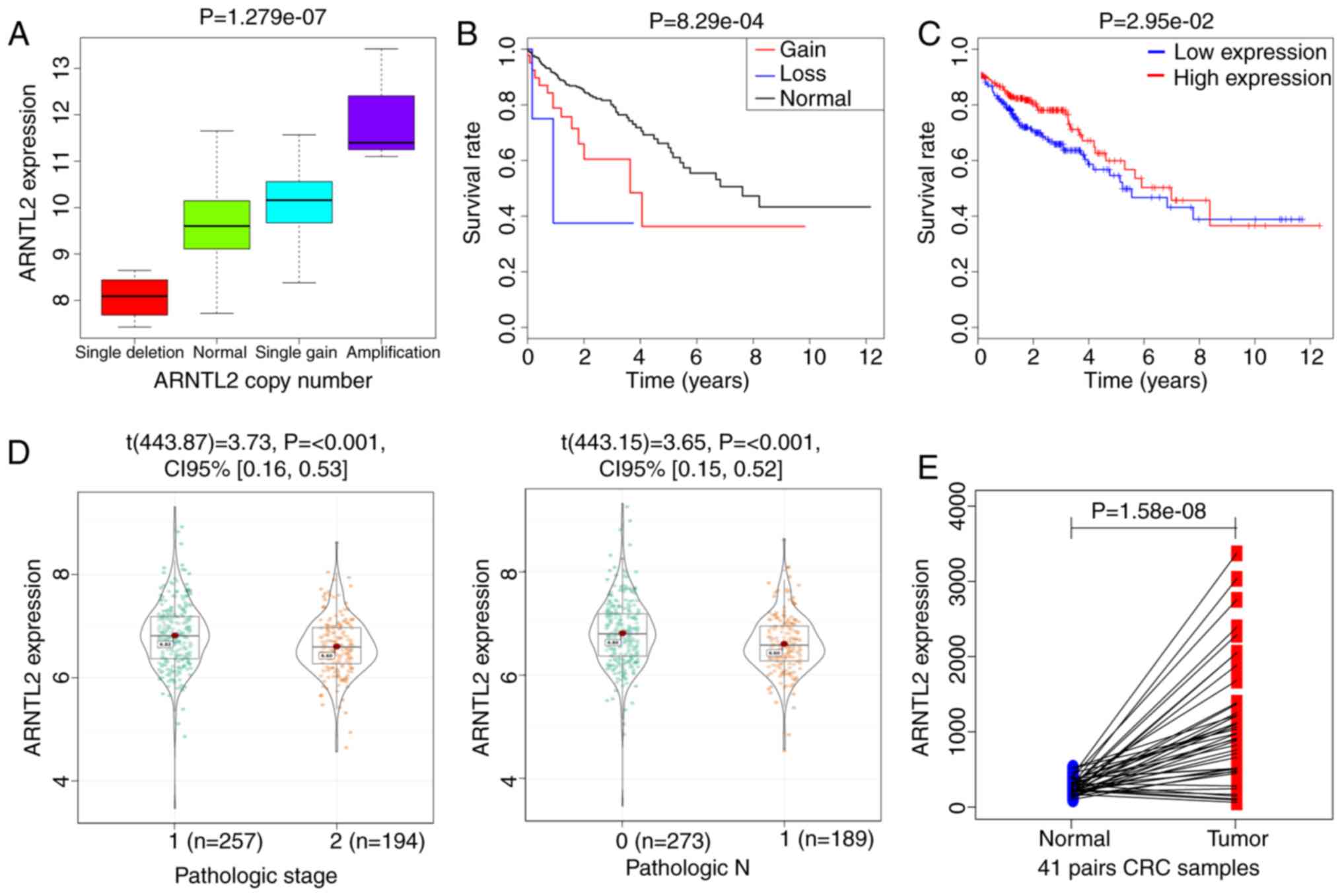|
1
|
Bray F, Ferlay J, Soerjomataram I, Siegel
RL, Torre LA and Jemal A: Global cancer statistics 2018: GLOBOCAN
estimates of incidence and mortality worldwide for 36 cancers in
185 countries. CA Cancer J Clin. 68:394–424. 2018. View Article : Google Scholar : PubMed/NCBI
|
|
2
|
Siegel RL, Miller KD, Fedewa SA, Ahnen DJ,
Meester RGS, Barzi A and Jemal A: Colorectal cancer statistics,
2017. CA Cancer J Clin. 67:177–193. 2017. View Article : Google Scholar : PubMed/NCBI
|
|
3
|
Calvert PM and Frucht H: The genetics of
colorectal cancer. Ann Intern Med. 137:603–612. 2002. View Article : Google Scholar : PubMed/NCBI
|
|
4
|
Liu F and Chang HC: Physiological links of
circadian clock and biological clock of aging. Protein Cell.
8:477–488. 2017. View Article : Google Scholar : PubMed/NCBI
|
|
5
|
Kondratov R: Circadian clock and cancer
therapy: An unexpected journey. Ann Med. 46:189–190. 2014.
View Article : Google Scholar : PubMed/NCBI
|
|
6
|
Sahar S and Sassone-Corsi P: Metabolism
and cancer: The circadian clock connection. Nat Rev Cancer.
9:886–896. 2009. View
Article : Google Scholar : PubMed/NCBI
|
|
7
|
Kelleher FC, Rao A and Maguire A:
Circadian molecular clocks and cancer. Cancer Lett. 342:9–18. 2014.
View Article : Google Scholar : PubMed/NCBI
|
|
8
|
Stevens RG, Brainard GC, Blask DE, Lockley
SW and Motta ME: Breast cancer and circadian disruption from
electric lighting in the modern world. CA Cancer J Clin.
64:207–218. 2014. View Article : Google Scholar : PubMed/NCBI
|
|
9
|
Polo A, Singh S, Crispo A, Russo M,
Giudice A, Montella M, Colonna G and Costantini S: Evaluating the
associations between human circadian rhythms and dysregulated genes
in liver cancer cells. Oncol Lett. 14:7353–7359. 2017.PubMed/NCBI
|
|
10
|
Momma T, Okayama H, Saitou M, Sugeno H,
Yoshimoto N, Takebayashi Y, Ohki S and Takenoshita S: Expression of
circadian clock genes in human colorectal adenoma and carcinoma.
Oncol Lett. 14:5319–5325. 2017.PubMed/NCBI
|
|
11
|
Wendeu-Foyet MG, Koudou Y, Cénée S,
Trétarre B, Rébillard X, Cancel-Tassin G, Cussenot O, Boland A,
Bacq D, Deleuze JF, et al: Circadian genes and risk of prostate
cancer: Findings from the EPICAP study. Int J Cancer.
145:1745–1753. 2019. View Article : Google Scholar : PubMed/NCBI
|
|
12
|
Bragantini D, Sivertsen B, Gehrman P,
Lydersen S and Güzey IC: Variations in circadian genes and
individual nocturnal symptoms of insomnia. The HUNT study.
Chronobiol Int. 36:681–688. 2019. View Article : Google Scholar : PubMed/NCBI
|
|
13
|
Cooper GM, Nickerson DA and Eichler EE:
Mutational and selective effects on copy-number variants in the
human genome. Nat Genet. 39:S22–S29. 2007. View Article : Google Scholar : PubMed/NCBI
|
|
14
|
Deng ZM, Liu L, Qiu WH, Zhang YQ, Zhong
HY, Liao P and Wu YH: Analysis of genomic variation in lung
adenocarcinoma patients revealed the critical role of PI3K complex.
PeerJ. 5:e32162017. View Article : Google Scholar : PubMed/NCBI
|
|
15
|
Diskin SJ, Hou C, Glessner JT, Attiyeh EF,
Laudenslager M, Bosse K, Cole K, Mossé YP, Wood A, Lynch JE, et al:
Copy number variation at 1q21.1 associated with neuroblastoma.
Nature. 459:987–991. 2009. View Article : Google Scholar : PubMed/NCBI
|
|
16
|
Cui M, Zheng M, Sun B, Wang Y, Ye L and
Zhang X: A long noncoding RNA perturbs the circadian rhythm of
hepatoma cells to facilitate hepatocarcinogenesis. Neoplasia.
17:79–88. 2015. View Article : Google Scholar : PubMed/NCBI
|
|
17
|
Ikeda M, Yu W, Hirai M, Ebisawa T, Honma
S, Yoshimura K, Honma KI and Nomura M: cDNA cloning of a novel
bHLH-PAS transcription factor superfamily gene, BMAL2: Its mRNA
expression, subcellular distribution, and chromosomal localization.
Biochem Biophys Res Commun. 275:493–502. 2000. View Article : Google Scholar : PubMed/NCBI
|
|
18
|
Schoenhard JA, Smith LH, Painter CA, Eren
M, Johnson CH and Vaughan DE: Regulation of the PAI-1 promoter by
circadian clock components: Differential activation by BMAL1 and
BMAL2. J Mol Cell Cardiol. 35:473–481. 2003. View Article : Google Scholar : PubMed/NCBI
|
|
19
|
He CX, Avner P, Boitard C and Rogner UC:
Downregulation of the circadian rhythm related gene Arntl2
suppresses diabetes protection in Idd6 NOD.C3H congenic mice. Clin
Exp Pharmacol Physiol. 37:1154–1158. 2010. View Article : Google Scholar : PubMed/NCBI
|
|
20
|
Olkkonen J, Kouri VP, Kuusela E, Ainola M,
Nordström D, Eklund KK and Mandelin J: DEC2 blocks the effect of
the ARNTL2/NPAS2 dimer on the expression of PER3 and DBP. J
Circadian Rhythms. 15:62017. View
Article : Google Scholar : PubMed/NCBI
|
|
21
|
Mazzoccoli G, Pazienza V, Panza A, Valvano
MR, Benegiamo G, Vinciguerra M, Andriulli A and Piepoli A: ARNTL2
and SERPINE1: Potential biomarkers for tumor aggressiveness in
colorectal cancer. J Cancer Res Clin Oncol. 138:501–511. 2012.
View Article : Google Scholar : PubMed/NCBI
|
|
22
|
Mocellin S, Tropea S, Benna C and Rossi
CR: Circadian pathway genetic variation and cancer risk: Evidence
from genome-wide association studies. BMC Med. 16:202018.
View Article : Google Scholar : PubMed/NCBI
|
|
23
|
Ha NH, Long J, Cai Q, Shu XO and Hunter
KW: The circadian rhythm gene Arntl2 is a metastasis susceptibility
gene for estrogen receptor-negative breast cancer. PLoS Genet.
12:e10062672016. View Article : Google Scholar : PubMed/NCBI
|
|
24
|
Robinson MD, McCarthy DJ and Smyth GK:
edgeR: A Bioconductor package for differential expression analysis
of digital gene expression data. Bioinformatics. 26:139–140. 2010.
View Article : Google Scholar : PubMed/NCBI
|
|
25
|
Huang da W, Sherman BT and Lempicki RA:
Systematic and integrative analysis of large gene lists using DAVID
bioinformatics resources. Nat Protoc. 4:44–57. 2009. View Article : Google Scholar : PubMed/NCBI
|
|
26
|
Smoot ME, Ono K, Ruscheinski J, Wang PL
and Ideker T: Cytoscape 2.8: New features for data integration and
network visualization. Bioinformatics. 27:431–432. 2011. View Article : Google Scholar : PubMed/NCBI
|
|
27
|
Li S, Shui K, Zhang Y, Lv Y, Deng W, Ullah
S, Zhang L and Xue Y: CGDB: A database of circadian genes in
eukaryotes. Nucleic Acids Res. 45:D397–D403. 2017.PubMed/NCBI
|
|
28
|
Subramanian A, Tamayo P, Mootha VK,
Mukherjee S, Ebert BL, Gillette MA, Paulovich A, Pomeroy SL, Golub
TR, Lander ES and Mesirov JP: Gene set enrichment analysis: A
knowledge-based approach for interpreting genome-wide expression
profiles. Proc Natl Acad Sci USA. 102:15545–15550. 2005. View Article : Google Scholar : PubMed/NCBI
|
|
29
|
Lin H and Zelterman D: Modeling survival
data: Extending the Cox model. Taylor & Francis. 85–86.
2002.
|
|
30
|
Karantanos T, Theodoropoulos G, Pektasides
D and Gazouli M: Clock genes: Their role in colorectal cancer.
World J Gastroenterol. 20:1986–1992. 2014. View Article : Google Scholar : PubMed/NCBI
|
|
31
|
Emons G, Spitzner M, Reineke S, Möller J,
Auslander N, Kramer F, Hu Y, Beissbarth T, Wolff HA, Rave-Fränk M,
et al: Chemoradiotherapy resistance in colorectal cancer cells is
mediated by Wnt/β-catenin signaling. Mol Cancer Res. 15:1481–1490.
2017. View Article : Google Scholar : PubMed/NCBI
|
|
32
|
Skrzypczak M, Goryca K, Rubel T, Paziewska
A, Mikula M, Jarosz D, Pachlewski J, Oledzki J and Ostrowski J:
Modeling oncogenic signaling in colon tumors by multidirectional
analyses of microarray data directed for maximization of analytical
reliability. PLoS One. 5:e130912010. View Article : Google Scholar : PubMed/NCBI
|
|
33
|
Kaiser S, Park YK, Franklin JL, Halberg
RB, Yu M, Jessen WJ, Freudenberg J, Chen X, Haigis K, Jegga AG, et
al: Transcriptional recapitulation and subversion of embryonic
colon development by mouse colon tumor models and human colon
cancer. Genome Biol. 8:R1312007. View Article : Google Scholar : PubMed/NCBI
|
|
34
|
Amin MB, Edge S, Greene F, Byrd DR,
Brookland RK, Washington MK, Gershenwald JE, Compton CC, Hess KR,
Sullivan DC, et al: AJCC cancer staging manualSpringer
International Publishing; 2017
|
|
35
|
Slattery ML, Mullany LE, Wolff RK, Sakoda
LC, Samowitz WS and Herrick JS: The p53-signaling pathway and
colorectal cancer: Interactions between downstream p53 target genes
and miRNAs. Genomics. 111:762–771. 2019. View Article : Google Scholar : PubMed/NCBI
|
|
36
|
Laissue P: The forkhead-box family of
transcription factors: Key molecular players in colorectal cancer
pathogenesis. Mol Cancer. 18:52019. View Article : Google Scholar : PubMed/NCBI
|
|
37
|
Zhang F, Gu W, Hurles ME and Lupski JR:
Copy number variation in human health, disease, and evolution. Annu
Rev Genomics Hum Genet. 10:451–481. 2009. View Article : Google Scholar : PubMed/NCBI
|
|
38
|
Falchi M, El-Sayed Moustafa JS, Takousis
P, Pesce F, Bonnefond A, Andersson-Assarsson JC, Sudmant PH,
Dorajoo R, Al-Shafai MN, Bottolo L, et al: Low copy number of the
salivary amylase gene predisposes to obesity. Nat Genet.
46:492–497. 2014. View Article : Google Scholar : PubMed/NCBI
|
|
39
|
Tanenbaum DG, Hall WA, Colbert LE, Bastien
AJ, Brat DJ, Kong J, Kim S, Dwivedi B, Kowalski J, Landry JC and Yu
DS: TNFRSF10C copy number variation is associated with metastatic
colorectal cancer. J Gastrointest Oncol. 7:306–314. 2016.
View Article : Google Scholar : PubMed/NCBI
|
|
40
|
Clevers H and Nusse R: Wnt/β-catenin
signaling and disease. Cell. 149:1192–1205. 2012. View Article : Google Scholar : PubMed/NCBI
|
|
41
|
Silva AL, Dawson SN, Arends MJ, Guttula K,
Hall N, Cameron EA, Huang TH, Brenton JD, Tavaré S, Bienz M and
Ibrahim AE: Boosting Wnt activity during colorectal cancer
progression through selective hypermethylation of Wnt signaling
antagonists. BMC Cancer. 14:8912014. View Article : Google Scholar : PubMed/NCBI
|
|
42
|
Sun S, Zhou L, Yu Y, Zhang T and Wang M:
Knocking down clock control gene CRY1 decreases adipogenesis via
canonical Wnt/β-catenin signaling pathway. Biochem Biophys Res
Commun. 506:746–753. 2018. View Article : Google Scholar : PubMed/NCBI
|
|
43
|
He Y, Lin F, Chen Y, Tan Z, Bai D and Zhao
Q: Overexpression of the circadian clock gene Rev-erbα affects
murine bone mesenchymal stem cell proliferation and osteogenesis.
Stem Cells Dev. 24:1194–1204. 2015. View Article : Google Scholar : PubMed/NCBI
|
|
44
|
Kettner NM, Katchy CA and Fu L: Circadian
gene variants in cancer. Ann Med. 46:208–220. 2014. View Article : Google Scholar : PubMed/NCBI
|
|
45
|
Angelousi A, Kassi E, Nasiri-Ansari N,
Weickert MO, Randeva H and Kaltsas G: Clock genes alterations and
endocrine disorders. Eur J Clin Invest. 48:e129272018. View Article : Google Scholar : PubMed/NCBI
|
|
46
|
Relles D, Sendecki J, Chipitsyna G, Hyslop
T, Yeo CJ and Arafat HA: Circadian gene expression and
clinicopathologic correlates in pancreatic cancer. J Gastrointest
Surg. 17:443–450. 2013. View Article : Google Scholar : PubMed/NCBI
|
|
47
|
Zhao H, Zeng ZL, Yang J, Jin Y, Qiu MZ, Hu
XY, Han J, Liu KY, Liao JW, Xu RH and Zou QF: Prognostic relevance
of Period1 (Per1) and Period2 (Per2) expression in human gastric
cancer. Int J Clin Exp Pathol. 7:619–630. 2014.PubMed/NCBI
|
|
48
|
Xue X, Liu F, Han Y, Li P, Yuan B, Wang X,
Chen Y, Kuang Y, Zhi Q and Zhao H: Silencing NPAS2 promotes cell
growth and invasion in DLD-1 cells and correlated with poor
prognosis of colorectal cancer. Biochem Biophys Res Commun.
450:1058–1062. 2014. View Article : Google Scholar : PubMed/NCBI
|
|
49
|
Innominato PF, Roche VP, Palesh OG,
Ulusakarya A, Spiegel D and Lévi FA: The circadian timing system in
clinical oncology. Ann Med. 46:191–207. 2014. View Article : Google Scholar : PubMed/NCBI
|
|
50
|
Mazzoccoli G, Piepoli A, Carella M, Panza
A, Pazienza V, Benegiamo G, Palumbo O and Ranieri E: Altered
expression of the clock gene machinery in kidney cancer patients.
Biomed Pharmacother. 66:175–179. 2012. View Article : Google Scholar : PubMed/NCBI
|
|
51
|
Kovanen L, Saarikoski ST, Haukka J,
Pirkola S, Aromaa A, Lönnqvist J and Partonen T: Circadian clock
gene polymorphisms in alcohol use disorders and alcohol
consumption. Alcohol Alcohol. 45:303–311. 2010. View Article : Google Scholar : PubMed/NCBI
|
|
52
|
Karantanos T, Theodoropoulos G, Gazouli M,
Vaiopoulou A, Karantanou C, Stravopodis DJ, Bramis K, Lymperi M and
Pektasidis D: Association of the clock genes polymorphisms with
colorectal cancer susceptibility. J Surg Oncol. 108:563–567. 2013.
View Article : Google Scholar : PubMed/NCBI
|
|
53
|
Forbes SA, Beare D, Boutselakis H, Bamford
S, Bindal N, Tate J, Cole CG, Ward S, Dawson E, Ponting L, et al:
COSMIC: Somatic cancer genetics at high-resolution. Nucleic Acids
Res. 45:D777–D783. 2017. View Article : Google Scholar : PubMed/NCBI
|
|
54
|
Ciarleglio CM, Ryckman KK, Servick SV,
Hida A, Robbins S, Wells N, Hicks J, Larson SA, Wiedermann JP,
Carver K, et al: Genetic differences in human circadian clock genes
among worldwide populations. J Biol Rhythms. 23:330–340. 2008.
View Article : Google Scholar : PubMed/NCBI
|
|
55
|
Brady JJ, Chuang CH, Greenside PG, Rogers
ZN, Murray CW, Caswell DR, Hartmann U, Connolly AJ, Sweet-Cordero
EA, Kundaje A and Winslow MM: An Arntl2-driven secretome enables
lung adenocarcinoma metastatic self-sufficiency. Cancer Cell.
29:697–710. 2016. View Article : Google Scholar : PubMed/NCBI
|
















